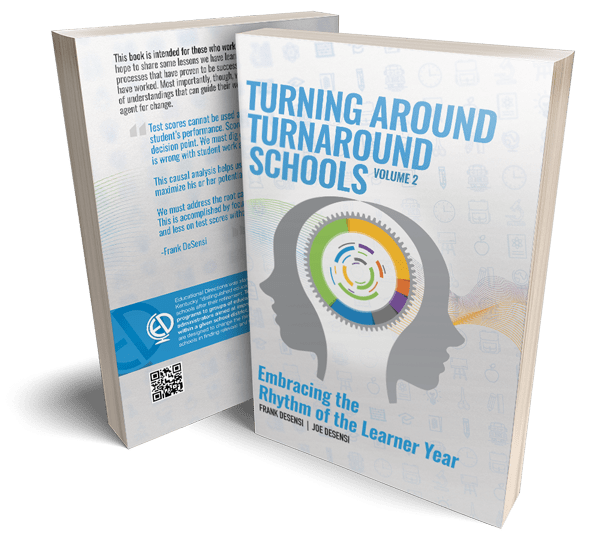Evaluating the Opening Period of Your School Year
“Evaluating the Opening Period of Your School Year” is a comprehensive, downloadable tool designed to assist educational leaders in planning and executing a successful start
The toolkits provided on this page are provided as a free service to teachers and school administrators. These tools are part of Turning Around Turnaround Schools, Volume 2 – Embracing the Rhythm of the Learner Year, a book by Educational Directions leaders Joe DeSensi, Ed.D. and Frank DeSensi. If you would like more information about the tools on this site, please contact us.
In the book, we emphasize both the neuroscience of how students learn and how they access that learning to perform at the level required when that learning is assessed/measured. We look at the whole child, taking into account both cognitive and noncognitive abilities and indicators. This whole-child focus is the basis for the just-in-time approach to developing the culture and climate, unpacking standards, building independent learners, making those learners performers, winning hearts and minds to get the best effort for assessments, and mitigating the summer losses of content and process.

Schools must understand that the Opening Period is critical. Ed Directions coaches say you can’t win the school year in the opening weeks, but you can sometimes lose it. It’s that important. The focus of the Opening Period is to get the students ready for the school. It is a time to equip them with the things they need to be successful and to develop the rituals and routines that will enable them to do the learner and performer work that they will need to grow toward proficiency. We like to say that if we have students who do not behave, cannot do the work required, or have not mastered critical rituals and routines, we haven’t opened school. In several of the schools in which we worked, the staff was still trying to open the school as a learning institution in December or even March.
“Evaluating the Opening Period of Your School Year” is a comprehensive, downloadable tool designed to assist educational leaders in planning and executing a successful start
“School Leadership Readiness – Are We Ready For Students?” is a comprehensive, downloadable tool designed to help educators prepare effectively for the new school
The School Dashboard for “At-Risk” Indicators is a powerful, downloadable tool designed to assist educators in identifying and supporting students who may be at risk
“Success Indicators” is a comprehensive, downloadable tool designed to empower educators with the data they need to enhance student learning outcomes. This initial student profile
If we have equipped students for success, our task becomes to make them more proficient learners and build their potential as independent performers. The focus is on building proficiency doing all the levels of learner work in developing the five legs that will support proficient performance in the next period. The Formative Period is critical. We can achieve a year’s growth of student potential in the Formative Period if we get all students highly engaged in rigorous learning work.
Description: The Formative Period is a time when the focus is on building proficient learners. Content is covered, and students begin learning to use what
In the first half of the Formative Period, our focus is on building the learner as well as learning the content. If we want to
In the Formative Period, students must attend, acquire, organize, and create meaning for what they are learning. This daily activity of building long-term memory is
The Formative Period can be a period of rapid growth in student knowledge base and performance potential. Teachers can reduce performance gaps and support non-traditional
If students are not ready for the Formative Period, there will not be a Formative Period. The Formative Period is about building each student’s potential
If we have managed to get students to develop as learners, we must add a new task. If students can learn, we have to prepare them to demonstrate what they have learned on a complex, rigorous test of long-term memory. The learning experiences started in the Formative Period continue, but students must also engage in escalating experiences (experiences that become more rigorous and complex), equivalent experiences (experiences working at the level of the state assessment), and calibrating experiences that gradually increase the rigor and complexity of both learning work and assessing work.
By the end of the Calibrating Period, administrators and academic leaders need to start designing the optimal environment for the Testing Period and develop a
Description: The Calibrating Period is divided into two sub-periods. The first focuses on supporting student development as a performer — especially as a test taker.
Another example of a period that is critical but not in itself sufficient is the Testing Period. Most schools seek to administer tests in an efficient manner that is consistent with state confidentiality and ethical requirements. The distribution of time, the organization of students, and other decisions are driven by an adult need to have an efficient, trouble-free testing cycle. There is another way. If we look at the Testing Period from the student perspective and focus on building an optimal assessment environment, we have to deal with a different set of priorities. We found there are things we can do that make taking tests less stressful and more manageable from the students’ point of view and create an optimal environment for students.
A turnaround school principal asked her Ed Directions’ coach how important the Testing Period was in the overall scope of things. The coach answered that
During the Testing Period, we look for different types of work in each phase of the period. Linking work and task analysis work are critical
Description: The Testing Period is not just the time when the test is administered to all students. It is the time when we build an
In planning for the Testing Period, we must make our plans and build our environment from the student perspective first and then develop the adult
The End-of-Year is often overlooked as administrators and teachers seek to get everyone out of the building successfully and without suffering casualties. In this push, schools often miss an opportunity to deal with student performance issues (e.g., performance loss over the summer, loss of work ethic, etc.) by failing to provide effective cumulative or capstone work. The EOY is critical for organizing long-term memory, linking common learnings across disciplines, and preparing for successful grade transitions.
The most important thing about the EOY is that students see the period work as academically important. The weeks or days left in the school
Description: The End-of-Year (EOY) Period moves the students from the state Testing Period through the last day of school. In best practice, it is a
The End of Year Unit Review tool is designed to facilitate a structured and thorough reflection, self-assessment, and planning process during the final period of
Another area that teachers need to complete to bring to closure at the end of the year is a development of a student profile, as
“Evaluating the End of the Year Period: A Principal Self Evaluation” is a comprehensive, downloadable tool designed to help school principals and education administrators reflect
School Improvement & Planning | Academic Audits & Consulting | Professional & Leadership Development
